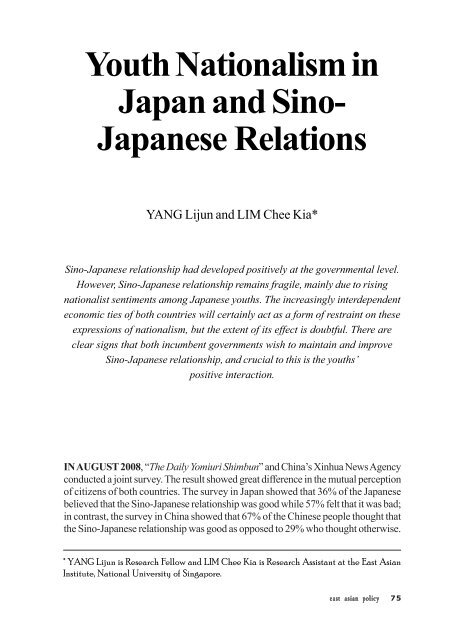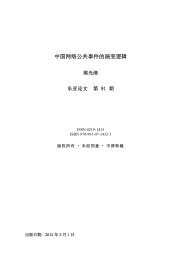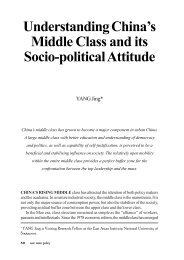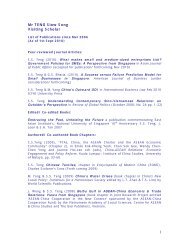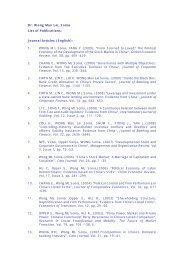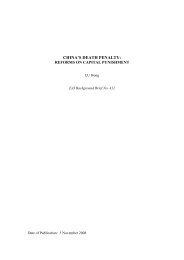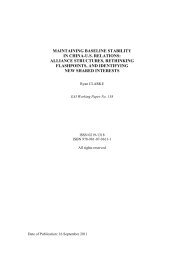Youth Nationalism in Japan and Sino- Japanese Relations
Youth Nationalism in Japan and Sino- Japanese Relations
Youth Nationalism in Japan and Sino- Japanese Relations
You also want an ePaper? Increase the reach of your titles
YUMPU automatically turns print PDFs into web optimized ePapers that Google loves.
This has led the <strong>Japan</strong>ese to seriously doubt Ch<strong>in</strong>a’s freedom of speech, not just at thejudicial level but also at the societal <strong>and</strong> political level. This is the source of <strong>Japan</strong>’s anti-Ch<strong>in</strong>a sentiments.”While these reasons are worth look<strong>in</strong>g <strong>in</strong>to, they did not address the fundamentaldomestic nature of <strong>Japan</strong>ese anti-Ch<strong>in</strong>a sentiments, fuelled by widespread nationalismamong <strong>Japan</strong>ese youths.Some <strong>Japan</strong>ese scholars such as Kazuo Ogawa agree that “the <strong>Japan</strong>ese arefrustrated over the nation’s economic growth (or rather the lack of it), political stagnationFIGURE 1 GENRO NPO’S SURVEY ON IMPRESSIONS OFJAPAN AND CHINAQUESTION: WHAT IMPRESSIONS DO YOU HAVE OF CHINA OR JAPAN?<strong>Japan</strong>Ch<strong>in</strong>aSource: <strong>Japan</strong>-Ch<strong>in</strong>a Jo<strong>in</strong>t Op<strong>in</strong>ion Polls, 17 August 2007, Genro NPOeast asian policy 77
<strong>and</strong> age<strong>in</strong>g population <strong>and</strong> hence see Ch<strong>in</strong>a as a vent<strong>in</strong>g channel for their dissatisfactions.Ch<strong>in</strong>a’s recent atta<strong>in</strong>ment of the status as an economic superpower <strong>and</strong> its rapid militarymodernisation might have contributed to this frustration. <strong>Japan</strong>ese’s frustration isexpressed <strong>in</strong> their denial or boycott of Ch<strong>in</strong>a”.It is this frustration which ignited nationalism <strong>and</strong> correspond<strong>in</strong>g <strong>Japan</strong>ese perceptionsof Ch<strong>in</strong>a. And such nationalism is probably much more dangerous than the anti-<strong>Japan</strong>sentiments of the Ch<strong>in</strong>ese, while fast <strong>in</strong> its proliferation, it also died down at an equallyspeedy pace.Discourses aris<strong>in</strong>g from <strong>Japan</strong>ese youth nationalismThe survey by <strong>Japan</strong>’s Central News Agency shows that the shift <strong>in</strong> <strong>Japan</strong>ese’sperception of Ch<strong>in</strong>a occurred sometime <strong>in</strong> 2005. The catalyst for this change was thewaves of anti-<strong>Japan</strong>ese protests <strong>in</strong> many of the major Ch<strong>in</strong>ese cities. In Ch<strong>in</strong>a, thesemovements soon died off. Thereafter, on the Ch<strong>in</strong>ese side, many events changed Ch<strong>in</strong>eseperceptions of <strong>Japan</strong>. The friendl<strong>in</strong>ess displayed by the <strong>Japan</strong> Rescue Team dur<strong>in</strong>g therecent Sichuan earthquake <strong>and</strong> the <strong>in</strong>nocence of <strong>Japan</strong>ese table tennis player FukuharaAi touched the hearts of many Ch<strong>in</strong>ese <strong>and</strong> improved the image of <strong>Japan</strong> among theCh<strong>in</strong>ese people. This might have caused many Ch<strong>in</strong>ese to believe that the S<strong>in</strong>o-<strong>Japan</strong>eserelationship is develop<strong>in</strong>g <strong>in</strong> the right direction. However, the improvement <strong>in</strong> <strong>Japan</strong>’simage amongst the Ch<strong>in</strong>ese did not cause a reciprocal improvement <strong>in</strong> the <strong>Japan</strong>ese’simpression of the Ch<strong>in</strong>ese.The nationalism of <strong>Japan</strong>ese youths is generally displayed <strong>in</strong> two spectrums, NationSuperiority Theory <strong>and</strong> Ch<strong>in</strong>a Detestation Theory. The former has often been coded as“Japonism” by <strong>Japan</strong>ese scholars. Japonism is a fad of the <strong>Japan</strong>ese culture with particularemphasis on art <strong>and</strong> its beauty judgement. Modern Japonism is expressed <strong>in</strong> threeways. Firstly, a renaissance of <strong>Japan</strong>ese culture, language <strong>and</strong> art among youths whoare <strong>in</strong>creas<strong>in</strong>gly enjoy<strong>in</strong>g public recital of <strong>Japan</strong>ese poems <strong>and</strong> literature works. A bookby Saitou Takashi entitled “Koe o Dashi Te Yomi Tai Nihongo” (Read<strong>in</strong>g <strong>Japan</strong>eselanguage through vocalisation) has sold 1.4 million copies s<strong>in</strong>ce its publication <strong>in</strong> 2001.This sort of <strong>Japan</strong>ese language <strong>and</strong> recital movement rem<strong>in</strong>ds one of the “recitaleducation” of pre-war <strong>Japan</strong>.Secondly, the <strong>in</strong>creased frequency of <strong>Japan</strong>ese youths s<strong>in</strong>g<strong>in</strong>g the National Anthem“Kimi ga yo” (May your reign last forever) with <strong>Japan</strong>ese flags drawn on their faces<strong>and</strong> waved <strong>in</strong> their h<strong>and</strong>s at sports events such as the Fifa World Cup is also seen as anexpression of ris<strong>in</strong>g nationalism.The third major expression of nationalism would be the youths’ participation <strong>in</strong> theYosakoi festival. The Yosakoi festival was orig<strong>in</strong>ally the traditional summer festival ofKochi City <strong>and</strong> is <strong>in</strong>creas<strong>in</strong>gly becom<strong>in</strong>g popular among <strong>Japan</strong>ese youths, who <strong>in</strong>fusedit with modern elements <strong>and</strong> transmitted it throughout the nation. The Yosakoi Festivalof 2002 held <strong>in</strong> Sapporo City attracted two million participants, most of them wereyouths <strong>in</strong> their 20s.The mass dance activity <strong>in</strong> these Yosakoi festivals is an important expression of<strong>Japan</strong>ese nationalism. <strong>Japan</strong>ese scholars believe that these Yosakoi festivals are useful78 east asian policy
for allow<strong>in</strong>g the <strong>Japan</strong>ese youths to not only vent their frustrations <strong>and</strong> release abundanceenergy but also rediscover their <strong>Japan</strong>ese identity <strong>and</strong> the uniqueness of <strong>Japan</strong>.A survey done among 15 to 20 year-old youths by a celebrated <strong>Japan</strong>ese columnist<strong>in</strong> 2007 showed that 53% of high school girls participated <strong>in</strong> the Yosakoi mass dance atleast once while at least 48% of their male counterparts did so. The survey also showedthat <strong>Japan</strong>ese youths have strong lik<strong>in</strong>gs for <strong>Japan</strong>ese cultural icons such as the kimono<strong>and</strong> <strong>Japan</strong>ese bath<strong>in</strong>g robe.The renaissance <strong>and</strong> rediscovery of <strong>Japan</strong>ese culture <strong>and</strong> nationalism brought abouta parallel rise <strong>and</strong> spread of detestation of Ch<strong>in</strong>a <strong>and</strong> Korea. While Ch<strong>in</strong>a detestationis not new <strong>in</strong> <strong>Japan</strong>, the Ch<strong>in</strong>a Detestation Theory has received a surge <strong>in</strong> its subscriptiondue to S<strong>in</strong>o-<strong>Japan</strong>ese frictions <strong>in</strong> recentyears. In particular, the anti-<strong>Japan</strong>esemovements <strong>in</strong> 2005, the East Ch<strong>in</strong>a SeaOil Field issue, the Yasukuni Shr<strong>in</strong>e issue<strong>and</strong> P<strong>in</strong>nacle Isl<strong>and</strong>s disputes provokedresentment among <strong>Japan</strong>ese youthstowards Ch<strong>in</strong>a. Actions by radical Ch<strong>in</strong>eseyouths (known as Fen Q<strong>in</strong>g, literally Angry<strong>Youth</strong>s) such as the burn<strong>in</strong>g of <strong>Japan</strong>’snational flag are perceived to have damaged<strong>Japan</strong>ese’s national pride.In response, the pre-exist<strong>in</strong>g Ch<strong>in</strong>aDetestation Theory spread rapidly on theInternet. The website “Channel Two”became the hottest gather<strong>in</strong>g spot forActions by radical Ch<strong>in</strong>eseyouths (known as Fen Q<strong>in</strong>g,literally Angry <strong>Youth</strong>s) suchas the burn<strong>in</strong>g of <strong>Japan</strong>’snational flag are perceived tohave damaged <strong>Japan</strong>ese’snational pride.subscribers of Ch<strong>in</strong>a Detestation Theory <strong>and</strong> Korea Detestation Theory amongst theyoung <strong>Japan</strong>ese.The choice of the <strong>in</strong>ternet as the medium, <strong>in</strong> which the theory is broadcasted, alongwith the help of other media such as books <strong>and</strong> newspapers, caused the Ch<strong>in</strong>a DetestationTheory to spread like wildfire. On 6 August 2005, the release of the comic book, “Amanga <strong>in</strong>troduction of Ch<strong>in</strong>a – decipher<strong>in</strong>g an antagonis<strong>in</strong>g neighbour” (Manga ChûgokuNyûmon -Yakka<strong>in</strong>a R<strong>in</strong>j<strong>in</strong> no Kenkyû, drawn by George Akiyama <strong>and</strong> produced byHuang Wenxiong) quickly became the hot topic of “Channel Two” <strong>and</strong> sold 180,000copies with<strong>in</strong> one <strong>and</strong> a half months’ time.Comic artist Yamano who is active <strong>in</strong> Channel Two also released his new work,“Manga Korea detestation” <strong>in</strong> the same period. By mid-August, both comics were topsellers <strong>in</strong> <strong>Japan</strong>’s Amazon.com website with the latter occupy<strong>in</strong>g the bestsell<strong>in</strong>g position<strong>and</strong> the former occupy<strong>in</strong>g second position. Between July 2005 <strong>and</strong> August 2007,“Manga Ken-Kan-ryû” (Manga Korea detestation) went <strong>in</strong>to its third volume <strong>and</strong>sold over a million copies. Its author, Yamano, released another comic titled “MangaKen-Chûgoku-ryû” (Manga Ch<strong>in</strong>a detestation ) <strong>in</strong> July 2008.Indeed, s<strong>in</strong>ce 2005, endless volumes of such “Ch<strong>in</strong>a detestation” literature havebeen published, of which, “Ch<strong>in</strong>a detestation theory - the Ch<strong>in</strong>a detested by the world”east asian policy 79
y a pro-<strong>in</strong>dependence Taiwanese scholar currently resid<strong>in</strong>g <strong>in</strong> <strong>Japan</strong>, Huang Wenxiong,serves as the iconic work. Interest<strong>in</strong>gly, more of such works have appeared after Ch<strong>in</strong>asuccessfully held the Olympics.Causes of <strong>Nationalism</strong> among <strong>Japan</strong>ese youthsMany factors contributed to the rise of <strong>Japan</strong>ese youths’ nationalism. <strong>Japan</strong>’snationalism has a long history with its roots traceable to some unique characteristics ofthe <strong>Japan</strong>ese nation. <strong>Japan</strong> has a strongsense of national crisis <strong>and</strong> a siege mentality.The <strong>in</strong>ability to cont<strong>in</strong>uewith the economic miracleof earlier years hit <strong>Japan</strong>ese’spride hard. In contrast,Ch<strong>in</strong>a has gone <strong>in</strong>to a phaseof accelerated economicgrowth s<strong>in</strong>ce the 1990s. Itssuccesses <strong>in</strong> other aspects ofdevelopment such as thesuccessful host<strong>in</strong>g of theBeij<strong>in</strong>g Olympic Games <strong>and</strong>the launch of ShenzhouSeven <strong>in</strong>to space havebrought tremendous prideto the Ch<strong>in</strong>ese.80 east asian policyPrior to the 17 th century, the <strong>Japan</strong>eseemulated Ch<strong>in</strong>ese Han culture, <strong>and</strong> thedeeper the emulation, the deeper the senseof <strong>in</strong>feriority they have for their own<strong>Japan</strong>ese culture. Gett<strong>in</strong>g over thisentanglement of cultural worshipp<strong>in</strong>g <strong>and</strong>sense of <strong>in</strong>feriority was a major issuechalleng<strong>in</strong>g the <strong>Japan</strong>ese scholars then.Some chose to ab<strong>and</strong>on the <strong>Japan</strong>eseidentity completely <strong>and</strong> become “s<strong>in</strong>icised”,while others chose to revert to <strong>Japan</strong>’sorig<strong>in</strong>al culture <strong>and</strong> utilise any rediscovereduniqueness of <strong>Japan</strong>ese culture toovercome the cultural <strong>in</strong>feriority.In the post-Meiji Restoration period,the same complex persisted with Europeanculture replac<strong>in</strong>g Ch<strong>in</strong>ese Han culture.From a historical viewpo<strong>in</strong>t, the <strong>Japan</strong>esehad never successfully overcome theirpsychological entanglement. The return of“Japonism” among <strong>Japan</strong>ese youths can beseen as an expression of such social <strong>and</strong>psychological complexities.<strong>Japan</strong>’s prewar nationalism reached itsheight <strong>in</strong> the late 19 th century <strong>and</strong> ceasedat the end of the Second World War. Follow<strong>in</strong>g its defeat, <strong>Japan</strong> concentrated oneconomic development <strong>and</strong> enjoyed decades of economic boom with lifetimeemployment guarantee. S<strong>in</strong>ce the 1990s however, <strong>Japan</strong>’s domestic situation has gonethrough an overhaul. The traditional promotion via seniority system has been on thedecl<strong>in</strong>e, thus chang<strong>in</strong>g the traditional “protector <strong>and</strong> protected” relationship betweencompanies <strong>and</strong> employees, <strong>and</strong> essentially chang<strong>in</strong>g <strong>Japan</strong> from a static society to afluid one. A stable employment relationship not only brought about societal stability, butalso allowed the companies as employers to replace the state as a target of loyalty. Ifpre-war nationalism had been absorbed by such private sector enterprises dur<strong>in</strong>g the
post-War period, then the dissolution of the company loyalty system could be understoodas a re-release of nationalism.The stagnation of <strong>Japan</strong>’s economy s<strong>in</strong>ce the 1990s, often known as the lost decade,has greatly <strong>in</strong>creased the economic uncerta<strong>in</strong>ty <strong>and</strong> <strong>in</strong>security of the new generation of<strong>Japan</strong>ese. A young <strong>Japan</strong>ese scholar, Takahara Hajimeakira, po<strong>in</strong>ted out that Ch<strong>in</strong>a<strong>and</strong> Korea detestation behaviour displayed by the <strong>Japan</strong>ese youths on the <strong>in</strong>ternet isl<strong>in</strong>ked to their <strong>in</strong>security with daily life as there is no <strong>in</strong>dication that they can be sure ofa better tomorrow. This <strong>in</strong>security <strong>and</strong> disappo<strong>in</strong>tment encourages youths to use thevirtual world of the <strong>in</strong>ternet as a space to vent their frustrations <strong>and</strong> both expressions ofCh<strong>in</strong>a <strong>and</strong> Korea detestations are outlets for such frustrations.The <strong>in</strong>ability to cont<strong>in</strong>ue with the economic miracle of earlier years hit <strong>Japan</strong>ese’spride hard. In contrast, Ch<strong>in</strong>a has gone <strong>in</strong>to a phase of accelerated economic growths<strong>in</strong>ce the 1990s. Its successes <strong>in</strong> other aspects of development such as the successfulhost<strong>in</strong>g of the Beij<strong>in</strong>g Olympic Games <strong>and</strong> the launch of Shenzhou Seven <strong>in</strong>to spacehave brought tremendous pride to the Ch<strong>in</strong>ese; these events became icons of Ch<strong>in</strong>a’srise, but they have also exerted more pressure on <strong>Japan</strong>ese pride. The contrast ofCh<strong>in</strong>a’s success <strong>and</strong> <strong>Japan</strong>’s relative “failure” hurt <strong>Japan</strong>’s pride <strong>and</strong> <strong>in</strong>stilled nationalismjust as the Meiji Restoration <strong>and</strong> Western <strong>in</strong>vasion had brought about the rise ofnationalism <strong>in</strong> Ch<strong>in</strong>a over a century ago.As S<strong>in</strong>o-<strong>Japan</strong>ese trade grows, cooperation with Ch<strong>in</strong>a has become a major elementof <strong>Japan</strong>’s economical recovery. Unfortunately, the <strong>Japan</strong>ese economy is not recover<strong>in</strong>gas fast as <strong>Japan</strong> wanted <strong>and</strong> there is a gap between its society’s expectations of Ch<strong>in</strong>a’srise <strong>and</strong> what it experiences <strong>in</strong> reality <strong>in</strong> its own country. Hence, Ch<strong>in</strong>a is perceived asmore of a competitor than a partner for <strong>Japan</strong>.Moreover, endless <strong>in</strong>cidents of food safety issues such as poisoned dumpl<strong>in</strong>gs <strong>and</strong>melam<strong>in</strong>e-contam<strong>in</strong>ated milk formulas, widespread official corruption <strong>and</strong> widen<strong>in</strong>g<strong>in</strong>come gaps have aggravated the negative images of Ch<strong>in</strong>a among the <strong>Japan</strong>ese. Thesenegative issues also became legitimate causes for Ch<strong>in</strong>a detestation. As a matter of fact,one of the ma<strong>in</strong> reasons for the popularity of “Manga Chûgoku Nyûmon - Yakka<strong>in</strong>aR<strong>in</strong>j<strong>in</strong> no Kenkyû” is the manga’s satirical portrayal of issues <strong>in</strong> Ch<strong>in</strong>a such as ecopollution,<strong>in</strong>tellectual property rights, money-worship<strong>in</strong>g <strong>and</strong> transnational crimes.<strong>Nationalism</strong> is also deliberately <strong>in</strong>stilled <strong>in</strong>to <strong>Japan</strong>ese youths as a by-product ofpatriotism. A <strong>Japan</strong>ese scholar, Yongwook Ryu, did a survey with the <strong>Japan</strong>ese Diet<strong>and</strong> found that there is a ris<strong>in</strong>g voice of conservative nationalism (known as Neo-<strong>Nationalism</strong>) over the years <strong>and</strong> these conservative politicians perceive that the public,especially <strong>Japan</strong>ese youths, lack patriotism. The demonstrations <strong>in</strong> Ch<strong>in</strong>a of 2005enhanced this view <strong>and</strong> caused the <strong>Japan</strong>ese to feel that Ch<strong>in</strong>ese youths were muchmore patriotic than their <strong>Japan</strong>ese counterparts, caus<strong>in</strong>g a “they have it, so I want tohave it too” syndrome. <strong>Japan</strong>ese politicians’ emphasis on the contribution of <strong>Japan</strong>’sSelf-Defence Force, the discussions on issues such as Constitution amendment to“normalise” <strong>Japan</strong>’s <strong>in</strong>ternational status, the populist policy of Koizumi <strong>and</strong> Sh<strong>in</strong>zo Abe’spledge to build a “beautiful country” all contributed to this neo-nationalism. It is a fusionof populism <strong>and</strong> nationalism.east asian policy 81
<strong>Japan</strong>ese <strong>Youth</strong> <strong>Nationalism</strong> <strong>and</strong> the Future of S<strong>in</strong>o-<strong>Japan</strong>ese <strong>Relations</strong>The <strong>in</strong>creas<strong>in</strong>g popularity of “Japonism” <strong>and</strong> “Ch<strong>in</strong>a Detestation Theory” is likely toimpact on the development of the S<strong>in</strong>o-<strong>Japan</strong>ese relationship. As a democracy, strongpopular sentiments <strong>in</strong> <strong>Japan</strong>, which <strong>in</strong>clude Japonism <strong>and</strong> the likes, have various sociopoliticalmechanisms of expression <strong>in</strong> the Diet that could <strong>in</strong>fluence <strong>Japan</strong>ese policymakers.It is still unclear how this will affect <strong>Japan</strong>’s foreign policy but <strong>Japan</strong> does havesuccessful precedents <strong>in</strong> mobilis<strong>in</strong>g <strong>and</strong> unit<strong>in</strong>g its population beh<strong>in</strong>d a certa<strong>in</strong> ideology.<strong>Japan</strong>ese elites <strong>in</strong> powerful political offices such as the Prime M<strong>in</strong>ister may, at times,wish to exploit such opportunities to achieve domestic or foreign policy goals. Koizumifor example, turned to populism to achieve the required support to implement domesticreforms at the expense of the S<strong>in</strong>o-<strong>Japan</strong>ese relationship.The development of nationalism among <strong>Japan</strong>ese youths is not decided merely bythe domestic situation but also <strong>in</strong>fluenced by their <strong>in</strong>teraction with the nationalisticsentiments of Ch<strong>in</strong>a’s angry youths. These Ch<strong>in</strong>ese nationalistic youths stoke the growthof <strong>Japan</strong>ese youth nationalism with their actions such as the burn<strong>in</strong>g of flags or flam<strong>in</strong>gon the <strong>in</strong>ternet. While Ch<strong>in</strong>a’s authoritarian government is better able to constra<strong>in</strong> thedevelopment of such sentiments for the sake of domestic stability, there will be timeswhen th<strong>in</strong>gs do get out of control.The new media <strong>and</strong> products of advanced technology such as the <strong>in</strong>ternet <strong>and</strong> otheradvance communication devices will make it more challeng<strong>in</strong>g for the Ch<strong>in</strong>esegovernment to cap domestic nationalistic sentiment. As new generations of Ch<strong>in</strong>esegrow <strong>in</strong>creas<strong>in</strong>gly confident of their nation, their sense of nationalism also grows <strong>in</strong>t<strong>and</strong>em.The <strong>in</strong>creas<strong>in</strong>gly <strong>in</strong>terdependent economic ties of both countries will certa<strong>in</strong>ly act assome form of restra<strong>in</strong>t on such nationalism, but it has its limitations. Dur<strong>in</strong>g Koizumi’sera, both nations experienced a prolonged period of “hot economics <strong>and</strong> cold politics”where economic cooperation appears to have little effect on cool<strong>in</strong>g political ties. Thereare clear signs that both <strong>in</strong>cumbent governments wish to ma<strong>in</strong>ta<strong>in</strong> <strong>and</strong> improve theS<strong>in</strong>o-<strong>Japan</strong>ese relationship, but, as Prime M<strong>in</strong>ister Aso po<strong>in</strong>ted out to reporters <strong>in</strong> hisrecent visit to Ch<strong>in</strong>a, “it is the youths who will open a new chapter <strong>in</strong> the S<strong>in</strong>o-<strong>Japan</strong>eserelationship”. 82 east asian policy


